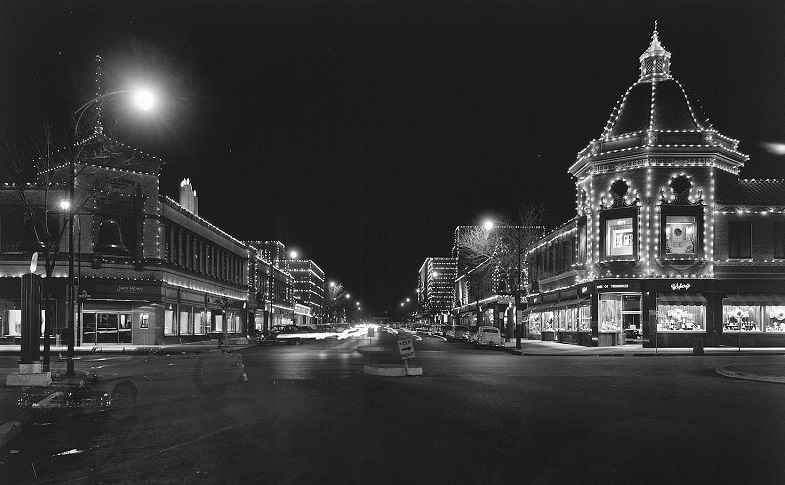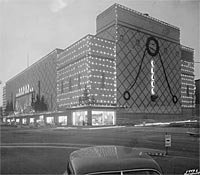On December 25, 1925, a string of Christmas lights hung over the doorway of the Mill Creek Building at the Country Club Plaza for the first time, beginning a tradition that today is one of the most extravagant Christmas light displays in the nation.
The Plaza shopping center had been conceived by Jesse Clyde "J. C." Nichols in 1912, when Brush Creek Valley was just an uninhabitable marsh with a nearby hog farm. J. C. Nichols, already a prominent real estate developer in areas south of Kansas City, believed that automobiles (as opposed to electric streetcars) would form the basis of future transportation. Therefore, the architects he hired, Edward Buehler Delk and George E. Kessler, planned the shopping center to have wide streets and considerable space devoted to convenient parking.
The location, five miles south of downtown Kansas City, seemed to pose a challenge. In an era in which virtually all upscale shopping occurred in the heart of cities connected to residential areas by electric streetcars, would shoppers drive their vehicles to a shopping center that was not downtown? When Nichols announced his plans in 1922, skeptics derided it as "Nichols’ folly."
To the great surprise of many observers, the Country Club Plaza, which is now considered the nation’s first suburban shopping center, was spectacularly successful after its first buildings opened in 1923. The Plaza’s attractive Spanish-style architecture, green spaces, and scenic location next to Brush Creek drew many customers. It also contributed to Nichols’s vision for long-term residential development. The apartments and homes surrounding an attractive and profitable shopping center, Nichols reasoned, would only increase in value.
In 1925, Charles "Pete" Pitrat, maintenance supervisor for the Nichols Company, hung Christmas lights on the Mill Creek Building for the first time. The display was hardly impressive by modern standards – just a few strands of Christmas tree lights hanging over a doorway with some small Christmas trees arranged along the sidewalk. From the display’s decidedly humble beginnings, Pitrat oversaw the installment of more lights on the buildings each year, beginning a tradition that continues today. Each Thanksgiving evening draws nearly 100,000 people who cram onto the Plaza to see the lighting ceremony for one of the nation’s most outstanding lighting displays.
Read full biographical sketches of the architects of the Plaza, prepared by the Missouri Valley Special Collections, The Kansas City Public Library.
- Biography of J. C. Nichols (1880-1950), Real Estate Developer, by Susan Jezak Ford, 2003.
- Biography of Edward Buehler Delk, (1885-1956), Architect; the chief architect of the Plaza, by Susan Jezak Ford, 1999.
- Biography of George E. Kessler (1862-1923), Landscape Architect; assisted with the overall layout of the Plaza and streets, by Susan Jezak Ford, 2003.
- Biography of Edward W. Tanner (1896-1974), Architect; designed most of the Plaza buildings, by Susan Jezak Ford, 2003.
- Biography of Sid J. (1860-1938) and S. Herbert Hare (?-1960), Landscape Architects; designed much of the Country Club District, by Daniel Coleman, 2008.
View images of the Plaza that are a part of the Missouri Valley Special Collections.
- Country Club Plaza, 47th & Mill Creek Blvd.; early postcard
- Country Club Plaza At Christmas, Sears and Roebuck, 1950
- Country Club Plaza Christmas Lights, 1950
- Country Club Plaza Christmas Lights, 1950, close up view
- Country Club Police and Fire Station; designed to look like an attractive home near the Plaza
Check out the following books about the Country Club Plaza.
- The Plaza, First and Always, by William S. Worley; a history of the plaza with photographs.
- The Plaza: Kansas City's World-Famous Shopping District, by David S. Hudson.
- City of Art, Kansas City's Public Art, by Tim Janicke; contains descriptions of noteworthy fountains and sculptures in the Country Club Plaza and other J. C. Nichols developments, pp. 146-179.
- J. C. Nichols and the Shaping of Kansas City, by William S. Worley; devotes chapter eight to the Plaza shopping center, with photographs, pp. 232-263.
- The J. C. Nichols Chronicle: The Authorized Story of the Man, His Company, and His Legacy, 1880-1994, by Robert Pearson; contains a concise history of the origins of the Plaza and its Christmas lights, pp. 91-106.
View the following documentaries about J. C. Nichols and the Country Club Plaza.
- Community Builder: The Life & Legacy of J.C. Nichols, by Steven C.F. Anderson and Brian Peter Falk, Kansas City Public Television.
- The Country Club Plaza, by Kaw Valley Films.
Continue researching the history of the Plaza using archival material held by the Missouri Valley Special Collections.
- Vertical File: Country Club Plaza--Christmas Lights
- Vertical File: Country Club Plaza
- Vertical File: J.C. Nichols Investment Company
- Vertical File: Nichols, Jesse Clyde
- Vertical File: Architects, Edward Buehler Delk
- Vertical File: Meyer, August R.
References:
Dory DeAngelo, What About Kansas City!: A Historical Handbook (Kansas City, MO: Two Lane Press, 1995), 143.
Susan Jezak Ford, Biography of Edward Buehler Delk, Architect, Missouri Valley Special Collections, 1999.
Robert Pearson, J. C. Nichols Chronicle: The Authorized Story of the Man, His Company, and His Legacy, 1880-1994 (Lawrence, KS: Country Club Plaza Press, Distributed by the University Press of Kansas, 1994), 91-106.
William S. Worley, J .C. Nichols and the Shaping of Kansas City (Columbia, MO: University of Missouri Press, 1990), 232-263.



